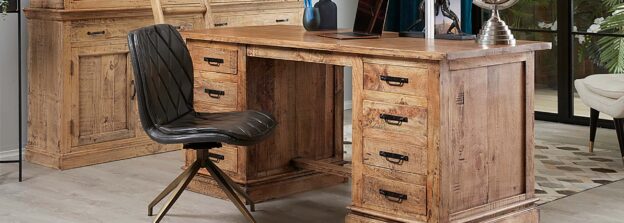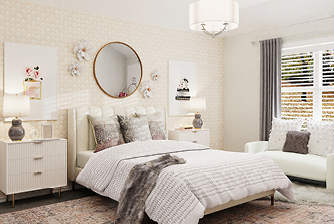In the era of remote work and digital connectivity, creating a home office that combines comfort, functionality, and productivity has become essential. The Modern Academia interior decor trend draws inspiration from modern aesthetics while incorporating warm wooden furniture, cosy soft furnishings, ample lighting, and inspiring decor elements. This article will guide you through the key elements of the Modern Academia trend to help you design a home office that promotes a productive workflow in a comfortable and stylish environment.
1. Incorporating warm wooden furniture Central to the trend is the use of deep, rich wooden pieces which exudes a sense of sophistication and natural beauty. Opt for a sturdy wooden desk, like one from Provincial Home Living that has ample workspace and storage options, such as built-in drawers or shelves. A solid wood desk not only adds visual appeal but also provides durability and a connection to nature.
Complement the desk with wooden bookshelves or a storage cabinet, like one from Koala Living for organising books, reference materials, and office supplies. The combination of wooden furniture pieces creates a cohesive and timeless aesthetic in your home office.
2. Cosy Soft Furnishings To create a comfortable and welcoming atmosphere in your home office, incorporate soft furnishings that invite relaxation and provide support. Invest in a comfortable and ergonomic office chair that promotes good posture and prevents fatigue during long working hours.
Add plush cushions and throws to your seating area to infuse a cosy ambiance. Consider incorporating a comfortable reading chair or a small sofa, like ones found at Focus on Furniture for moments of relaxation or contemplation, further enhancing the academia-inspired atmosphere.
3. Adequate Lighting Proper lighting is crucial for a productive workspace. Embrace natural light by positioning your desk near a window to benefit from daylight and a connection to the outside world. If natural light is limited, complement it with ambient lighting options, such as a stylish desk lamp or pendant lighting, which you can find plenty of stylish options at Adairs. Consider a focused desk lamp or adjustable spotlights to illuminate your work surface effectively. Layering different types of lighting creates a well-lit and visually appealing home office environment.
4. Inspiring Decor Elements Incorporate inspiring decor elements that reflect you and stimulate creativity and productivity. You can make this a DIY project and find prints that you like to hang on the wall including motivational quotes, inspirational artwork, or framed prints of literary works on the walls. You can even incorporate interesting pieces from Bed Bath N’ Table to add flair to your space. These decorative pieces help to infuse your workspace with individuality.
Integrate a chalkboard or a whiteboard for jotting down ideas, reminders, or creating to-do lists. Additionally, display a collection of books, either as a backdrop for your workspace or on open shelves, to showcase add visual interest.
5. Minimalist and Functional Organisation Maintaining a clutter-free and well-organised workspace is vital for productivity. Embrace minimalist storage solutions such as sleek desk organisers, file cabinets, or wall-mounted shelves to keep your essentials within reach and maintain a clean aesthetic. Be sure to visit Howards Storage World for even more storage solutions.
Invest in functional storage options like boxes, baskets, or magazine holders to neatly store papers, notebooks, and stationery. A clutter-free environment helps reduce distractions and allows for a more focused and efficient workflow.
The Modern Academia interior decor trend combines modern aesthetics with warmth, comfort, and functionality to create a home office conducive to productivity. By incorporating warm wooden furniture, cosy soft furnishings, adequate lighting, and inspiring decor elements, you can design a workspace that reflects sophistication, supporting your work needs, and inspiring a productive workflow. Remember, a well-designed and comfortable home office enhances your focus, creativity, and overall well-being.



































